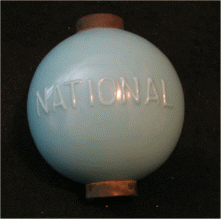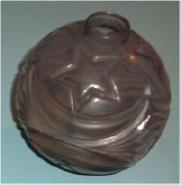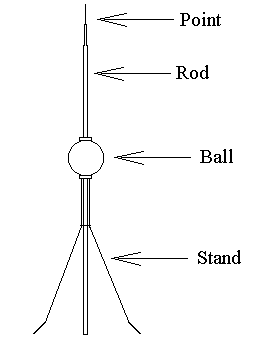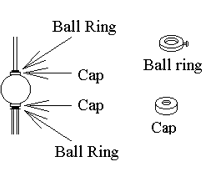National Depression Glass Association
Preserving America's Glass Manufacturing Heritage
Glass Lightning Rod Balls
by David Adams
This seems like a strange topic, but it definitely has a connection with American made glassware. I became interested in the subject when I borrowed an unusual piece of glass from Rick and Cindy Jones. It was a piece of Cambridge glass (below, left) in the "Azurite" color (from the early 1920s), but I had no idea what it was. It was a ball, with holes on the top and bottom, copper metal bands attached where the holes were, and with the word "National" in raised letters molded into the ball. I was determined to find out, and so I did. Here's the story.
 Historically, if one wanted to
avoid being struck by lightning, it was best to avoid going near a Church. Church
steeples were usually the highest point in town, and were often hit
by lightning strikes. This got
Benjamin Franklin speculating about lightning (remember the kite
experiment) and eventually he invented the lightning rod.
Historically, if one wanted to
avoid being struck by lightning, it was best to avoid going near a Church. Church
steeples were usually the highest point in town, and were often hit
by lightning strikes. This got
Benjamin Franklin speculating about lightning (remember the kite
experiment) and eventually he invented the lightning rod.
A lightning rod is also commonly called a lightning attractor or conductor. The idea is that if a lightning rod is placed high on a building, it will draw the lightning towards it instead of other structures. When mounting a lightning rod, it comes in contact with an aluminum or copper plate on the roof. A grounding cable is then run inconspicuously across the roof, down the side of the structure, and buried in the ground.
Toward the end of the 19th century and beginning
of the 20th, the
use of the lightning rod ball became commonplace. A number of
American companies produced the balls, Cambridge Glass Company
 being one of them. The one in the photograph (at left) was made by Cambridge for
the National Lightning Protection Co., a Canadian company.
being one of them. The one in the photograph (at left) was made by Cambridge for
the National Lightning Protection Co., a Canadian company.
With wide ranges of colors and designs available, many people began using these lightning rod balls as ornaments to decorate their lightning rods. These balls are quite collectible today. The one at right is called "Moon and Stars." Not all of them are round -- there are a number of different shapes that the "ball" would come in. I'll refer you to just one page on the web which displays quite a few of these colorful and interesting items: www.lightningrodparts.com/parts4.html.
There is actually a book on the subject. The Complete Book of Lightning Rod Balls (by Michael Bruner & Rod Krupka) was originally published in 1982, and a second edition came out in 1989. Both are long out of print, and I was unable to obtain one for use in writing this article.
Did antique lightning rod balls serve any purpose besides decoration? Not really. But, by installing a lightning rod ball on your lightning rod, you could detect if the rod was actually struck. The balls on a struck lightning rod would shatter. This made it easy to determine if there was a hit, and that the system should be examined for any damage.
Components of a Lightning Rod
 The diagram at right
illustrates the components of an antique style lightning rod. The
parts are described as follows:
The diagram at right
illustrates the components of an antique style lightning rod. The
parts are described as follows:
- Point or Tip
- The most common is the pointed tip, known as a "shell" point, as in artillery shell, shown in the sketch. The second most common tip is the bayonet tip, which looks like a three-sided military style bayonet.
- Rod
- Two types are the most common: The most common is known as "tube" rod, as it is a 5/8" diameter copper tube. Sometimes it has a seam, and sometimes the tube is seamless. The second most common type is "Twisted", or "star rod", also known as "section rod", as it came in 10 foot "sections".
- Ball
- There are several dozen different glass lightning rod ball shapes, sizes and colors. Entire books have been written covering the various ball designs, colors, etc. This is intended to be just a brief overview. The most common lightning rod ball is the 4½" diameter smooth round ball. The most common colors are opaque white, and opaque light blue. The next two most common colors are transparent cobalt blue and transparent red, sometimes known as "ruby" red. The holes in the top and bottom of the ball are the same size, and the hole and the area around it are known as "collars".
- Caps
- Most balls (but not all) originally had copper, aluminum, or in rare cases, brass "caps" on both ends. The purpose of the caps is to protect the ball and to cover up the rough glass edges created during the ball's normal manufacturing process.
- Ball Rings
 Ball rings are small rings with
a set screw in them that mount on the lightning rod above and
below the glass lightning rod ball.
Ball rings are small rings with
a set screw in them that mount on the lightning rod above and
below the glass lightning rod ball.- Stand or Brace
- The most common type is the "washer" brace or stand with three legs. These come in different sizes, with the most common sizes ranging from about 12 to 36 inches in total height. Almost all stands or "braces" were made of plain iron.
- Arrows & Weather Vanes
- Sometimes on one or more of the lightning rods, above the glass ball, there is an arrow or weather vane. Starting with arrows, they came in many sizes, but the 18" and 24"ones are the most common.
Some of the companies that manufactured (or purchased from glass companies) glass balls and other lightning rod equipment include the following, a few of which still remain in business today:
- Geo. E. Thompson Lightning Co., St. Paul, MN
Reyburn, Hunter, & Foy Co., Cincinatti, OH
W. C. Shinn System, Lincoln, NE, & Chicago, IL
George R. Kress Co., Pittsburgh, PA
Security Lightning Rod Co., Burlington, WI
Julius F. Goetz Lightning Rod Co., Hartford, WI
Dodd & Struthers "D&S" DesMoines, IA
Goshen Lightning Rod Co., Goshen, IN
Webmaster's NOTE: Most of the information regarding lightning rods came from the web site of New Old Products, Inc. (www.newoldproducts.com), whose owners granted the NDGA permission to use the information therein. This company sells replacement parts for antique lightning rods, including some brand new lightning balls. Visit their web site to see the new replacement balls - they're quite spectacular.